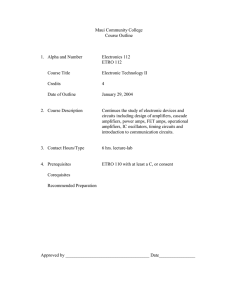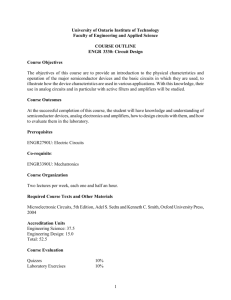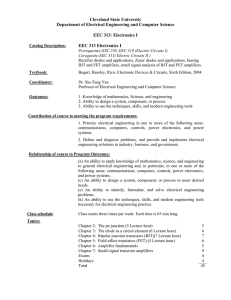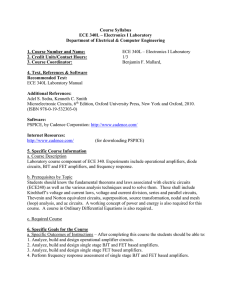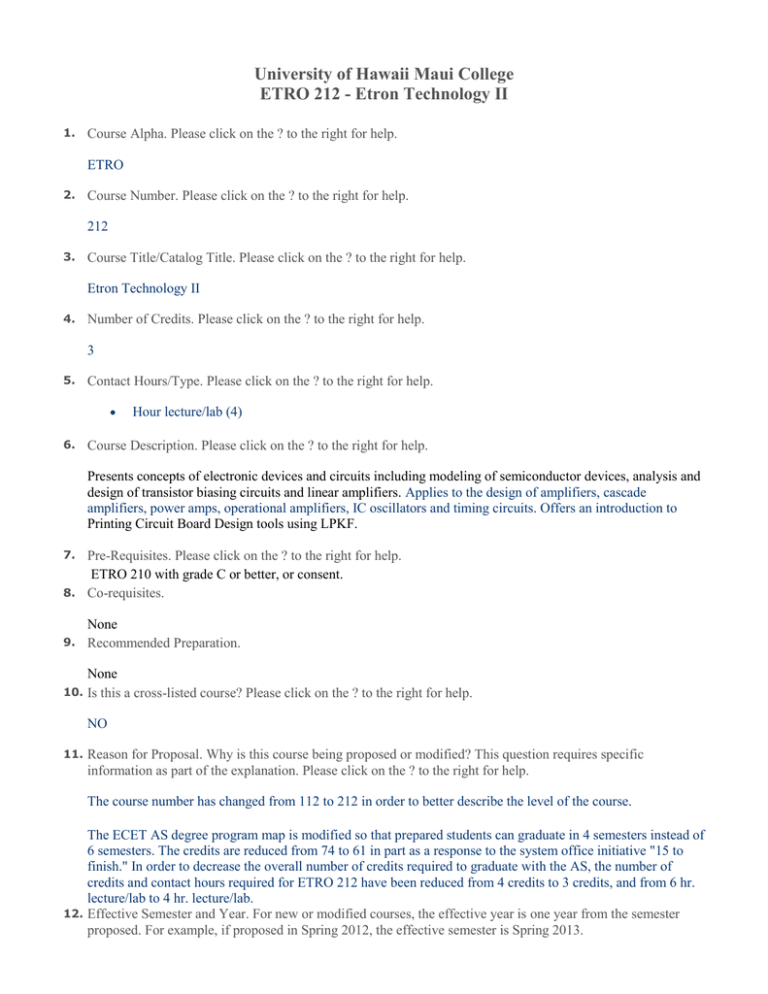
University of Hawaii Maui College
ETRO 212 - Etron Technology II
1.
Course Alpha. Please click on the ? to the right for help.
ETRO
2.
Course Number. Please click on the ? to the right for help.
212
3.
Course Title/Catalog Title. Please click on the ? to the right for help.
Etron Technology II
4.
Number of Credits. Please click on the ? to the right for help.
3
5.
Contact Hours/Type. Please click on the ? to the right for help.
6.
Hour lecture/lab (4)
Course Description. Please click on the ? to the right for help.
Presents concepts of electronic devices and circuits including modeling of semiconductor devices, analysis and
design of transistor biasing circuits and linear amplifiers. Applies to the design of amplifiers, cascade
amplifiers, power amps, operational amplifiers, IC oscillators and timing circuits. Offers an introduction to
Printing Circuit Board Design tools using LPKF.
7.
Pre-Requisites. Please click on the ? to the right for help.
ETRO 210 with grade C or better, or consent.
8. Co-requisites.
9.
None
Recommended Preparation.
10.
None
Is this a cross-listed course? Please click on the ? to the right for help.
NO
11.
Reason for Proposal. Why is this course being proposed or modified? This question requires specific
information as part of the explanation. Please click on the ? to the right for help.
The course number has changed from 112 to 212 in order to better describe the level of the course.
The ECET AS degree program map is modified so that prepared students can graduate in 4 semesters instead of
6 semesters. The credits are reduced from 74 to 61 in part as a response to the system office initiative "15 to
finish." In order to decrease the overall number of credits required to graduate with the AS, the number of
credits and contact hours required for ETRO 212 have been reduced from 4 credits to 3 credits, and from 6 hr.
lecture/lab to 4 hr. lecture/lab.
12. Effective Semester and Year. For new or modified courses, the effective year is one year from the semester
proposed. For example, if proposed in Spring 2012, the effective semester is Spring 2013.
Spring 2014
13.
Grading Method. What grading methods may be used for this course?
14.
Standard (Letter,Cr/NCr,Audit) (0)
Is this course repeatable for credit? How often can this course be counted toward a degree or certificate?
NO
15.
Course Student Learning Outcomes (SLOs). DO NOT ENTER TEXT IN THE TEXT BOX BELOW. Click on
the yellow button "COURSE LEARNING OUTCOMES" and enter in that screen.
Competency/ Course SLO
Describe the function, operation Analyze the operation Use test equipment
and characteristics of amplifier, of IC oscillator and
to troubleshoot
FET and OP AMP circuits.
timer circuits.
solid-state circuits.
Calculate the total gain of a cascade amplifier.
Measure the input and output waveform of a RC coupled
transistor amp.
Describe the operating characteristics of push-pull amps.
Measure the input/output waveforms of a push-pull amp.
Troubleshoot a faulted multistage amp circuit.
Describe the operating characteristics of FETs.
Identify basic FET amp configurations.
Measure the input/output waveforms of a common
source FET amp.
Identify the faulted component in a FET amp circuit.
Identify astable multivibrator circuits.
Identify monostable multivibrator circuits.
Identify bistable multivibrator circuits.
Describe the construction of IC operational amplifiers.
Measure the input/output waveforms of OP AMP.
Determine the faulty component in faulted OP AMP
circuits.
Identify the functional blocks of a receiver.
Describe the operating characteristics of receiver circuits.
Course SLO/PSLO
Analyze, design, and Utilize
Demonstrate critical
implement electro- appropriate engineering technology
optic systems, control mathematics skills and experiences such
systems,
at the level as: making existing
instrumentation
of algebra technology operate,
systems,
and
creating/selecting new
communication
trigonometry technology,
systems, computer
to solve
troubleshooting,
systems, or power
technical
calibrating, characterizing,
systems.
problems. and optimizing.
Demonstrate
engineer's
way of
thinking,
analyzing
technology
as systems.
Describe the function, operation and characteristics of
amplifier, FET and OP AMP circuits.
Analyze the operation of IC oscillator and timer circuits.
Use test equipment to troubleshoot solid-state circuits.
16. Course Competencies. DO NOT ENTER TEXT IN THE TEXT BOX BELOW. Click on the yellow button
"COURSE COMPETENCIES/ISSUES/SKILLS" and enter text in that screen. Course competencies are
smaller, simpler tasks that connect to and facilitate the SLOs.
Competency
Calculate the total gain of a cascade amplifier.
Measure the input and output waveform of a RC coupled transistor amp.
Describe the operating characteristics of push-pull amps.
Measure the input/output waveforms of a push-pull amp.
Troubleshoot a faulted multistage amp circuit.
Describe the operating characteristics of FETs.
Identify basic FET amp configurations.
Measure the input/output waveforms of a common source FET amp.
Identify the faulted component in a FET amp circuit.
Identify astable multivibrator circuits.
Identify monostable multivibrator circuits.
Identify bistable multivibrator circuits.
Describe the construction of IC operational amplifiers.
Measure the input/output waveforms of OP AMP.
Determine the faulty component in faulted OP AMP circuits.
Identify the functional blocks of a receiver.
Describe the operating characteristics of receiver circuits.
17. Recommended Course Content and Timeline. The course content facilitates the course competencies. Course
content may be organized by weeks, units, topics or the like.
Content
1-2 weeks Amplifier loading, bias stabilization, and gain.
1-2 weeks Push-pull amplifiers, power amplifiers, audio amplifiers.
1-2 weeks Troubleshooting amplifier circuits.
1-2 weeks FET and FET amplifiers.
1-2 weeks Differential amplifiers, operational amplifiers.
1-2 weeks Oscillators and IC oscillator circuits.
1-2 weeks Timer circuits and 555 timers.
1-2 weeks Receiver Circuits.
18. Program Learning Outcomes. DO NOT ENTER TEXT IN THE TEXT BOX BELOW. Click on the yellow
button "PLOs" and enter text in that screen. Program Student Learning Outcomes (PLOs) supported by this
course. If you are not a "program" use the Liberal Arts PLOs, view them by clicking on ? icon to the right.
Program SLO
Analyze, design, and implement electro-optic systems, control systems, instrumentation systems, communication systems,
computer systems, or power systems.
Utilize appropriate mathematics at the level of algebra and trigonometry to solve technical problems.
Demonstrate critical engineering technology skills and experiences such as: making existing technology operate,
creating/selecting new technology, troubleshooting, calibrating, characterizing, and optimizing.
Demonstrate engineer's way of thinking, analyzing technology as systems.
19. College-wide Academic Student Learning Outcomes (CASLOs). FIRST, fill out the CASLO grid located in the
UHMC tab above. Click on the HELP icon for tips on determining support for the CASLOs and indicate your
choices below by clicking on the box in front of each supported CASLO. NOTE: Our campus does not use the
Preparatory Level, Level 1 and Level 2 designations in the chart below.
Creativity - Able to express originality through a variety of forms.
Preparatory Level
Critical Thinking - Apply critical thinking skills to effectively address the challenges and solve problems.
Preparatory Level
Information Retrieval and Technology - Access, evaluate, and utilize information effectively, ethically, and responsibly.
Oral Communication - Practice ethical and responsible oral communications appropriately to a variety of audiences and
purposes.
Quantitative Reasoning - Synthesize and articulate information using appropriate mathematical methods to solve problems of
quantative reasoning accurately and appropriately.
Preparatory Level
Written Communication - Write effectively to convey ideas that meet the needs of specific audiences and purposes.
GenED SLO
Creativity - Able to express originality through a variety of forms.
Critical Thinking - Apply critical thinking skills to effectively address the challenges and solve problems.
Quantitative Reasoning - Synthesize and articulate information using appropriate mathematical methods to solve
problems of quantative reasoning accurately and appropriately.
20. Linking. CLICK ON CHAIN LINK ICON IN UPPER RIGHT HAND CORNER TO BEGIN LINKING.
21. Method(s) of delivery appropriate for this course. Please click on the ? to the right for help.
Classroom/Lab (0)
22. Text and Materials, Reference Materials, and Auxiliary Materials.
Materials:
Text(s) may be supplemented with:
- C.A.I. NIDA 130 DAAD Courseware
- Electronics Lab
- Accompanying practice exercises
Other:
- Scientific Calculator
- Engineering Notebook
Thomas L. Floyd and David M. Bucha. Electronics Fundamentals: circuits, devices, and
applications. 8th E. Pearson, Prentice Hall, 2010, 978-0-13-507295-0.
23. Maximum enrollment. Please click on the ? to the right for help.
The lab has equipment for a maximum of 16 students. With appropriate funding, the program could purchase
more equipment and allow up to 24 students in the lab.
24. Particular room type requirement. Is this course restricted to particular room type?
YES
A lab with the equipment needed to carry out the experiments like KAA 217.
25. Special scheduling considerations. Are there special scheduling considerations for this course?
YES
This class must fit the ECET AS degree course scheduling.
26. Are special or additional resources needed for this course?
Electronics equipment: power supplies, function generators, oscilloscopes, digital multimeter, PCB Machine,
computers and electronic components
Software packages: Multisim, Ultiboard, MATLAB.
27. Does this course require special fees to be paid for by students?
NO
28. Does this course change the number of required credit hours in a degree or certificate?
No.
29. Course designation(s) for the Liberal Arts A.A. degree and/or for the college's other associate degrees.
Degree
Program
Category
Associate in Arts:
Liberal Arts
LE - Elective
LE - Elective
ECET - All
AS:
PR - Program Requirement
AAS:
BAS:
Developmental/Remedial:
30. Course designation(s) for other colleges in the UH system.
This course transfers as an elective.
31. Indicate the year and page # of UHMC catalog referred to. For new or modified courses, please indicate the
catalog pages that need to be modified and provide a sheet outlining those changes.
Referred catalog and modifications: pages 48 and 113 in UHMC's 2012-2013 general catalog
32. College-wide Academic Student Learner Outcomes (CASLOs).
Standard 1 - Written Communication
Write effectively to convey ideas that meet the needs of specific audiences and purposes.
Outcome 1.1 - Use writing to discover and articulate ideas.
0
Outcome 1.2 - Identify and analyze the audience and purpose for any intended communication.
0
Outcome 1.3 - Choose language, style, and organization appropriate to particular purposes and audiences.
1
Outcome 1.4 - Gather information and document sources appropriately.
1
Outcome 1.5 - Express a main idea as a thesis, hypothesis, or other appropriate statement.
1
Outcome 1.6 - Develop a main idea clearly and concisely with appropriate content.
1
Outcome 1.7 - Demonstrate a mastery of the conventions of writing, including grammar, spelling, and mechanics.
0
Outcome 1.8 - Demonstrate proficiency in revision and editing.
1
Outcome 1.9 - Develop a personal voice in written communication.
0
Standard 2 - Quantitative Reasoning
Synthesize and articulate information using appropriate mathematical methods to solve problems of quantative reasoning
accurately and appropriately.
Outcome 2.1 - Apply numeric, graphic, and symbolic skills and other forms of quantitative reasoning accurately and appropriately. 3
Outcome 2.2 - Demonstrate mastery of mathematical concepts, skills, and applications, using technology when appropriate.
3
Outcome 2.3 - Communicate clearly and concisely the methods and results of quantitative problem solving.
2
Outcome 2.4 - Formulate and test hypotheses using numerical experimentation.
3
Outcome 2.5 - Define quantitative issues and problems, gather relevant information, analyze that information, and present results.
2
Outcome 2.6 - Assess the validity of statistical conclusions.
2
Standard 3 - Information Retrieval and Technology.
Access, evaluate, and utilize information effectively, ethically, and responsibly.
Outcome 3.1 - Use print and electronic information technology ethically and responsibly.
1
Outcome 3.2 - Demonstrate knowledge of basic vocabulary, concepts, and operations of information retrieval and technology.
1
Outcome 3.3 - Recognize, identify, and define an information need.
1
Outcome 3.4 - Access and retrieve information through print and electronic media, evaluating the accuracy and authenticity of that 1
information.
Outcome 3.5 - Create, manage, organize, and communicate information through electronic media.
1
Outcome 3.6 - Recognize changing technologies and make informed choices about their appropriateness and use.
2
Standard 4 - Oral Communication
Practice ethical and responsible oral communications appropriately to a variety of audiences and purposes.
Outcome 4.1 - Identify and analyze the audience and purpose of any intended communication.
0
Outcome 4.2 - Gather, evaluate, select, and organize information for the communication.
1
Outcome 4.3 - Use language, techniques, and strategies appropriate to the audience and occasion.
0
Outcome 4.4 - Speak clearly and confidently, using the voice, volume, tone, and articulation appropriate to the audience and
occasion.
0
Outcome 4.5 - Summarize, analyze, and evaluate oral communications and ask coherent questions as needed.
1
Outcome 4.6 - Use competent oral expression to initiate and sustain discussions.
1
Standard 5 - Critical Thinking
Apply critical thinking skills to effectively address the challenges and solve problems.
Outcome 5.1 - Identify and state problems, issues, arguments, and questions contained in a body of information.
3
Outcome 5.2 - Identify and analyze assumptions and underlying points of view relating to an issue or problem.
3
Outcome 5.3 - Formulate research questions that require descriptive and explanatory analyses.
3
Outcome 5.4 - Recognize and understand multiple modes of inquiry, including investigative methods based on observation and
analysis.
2
Outcome 5.5 - Evaluate a problem, distinguishing between relevant and irrelevant facts, opinions, assumptions, issues, values, and 3
biases through the use of appropriate evidence.
Outcome 5.6 - Apply problem-solving techniques and skills, including the rules of logic and logical sequence.
3
Outcome 5.7 - Synthesize information from various sources, drawing appropriate conclusions.
2
Outcome 5.8 - Communicate clearly and concisely the methods and results of logical reasoning.
2
Outcome 5.9 - Reflect upon and evaluate their thought processes, value system, and world views in comparison to those of others.
2
Standard 6 - Creativity
Able to express originality through a variety of forms.
Outcome 6.1: Generate responses to problems and challenges through intuition and non-linear thinking.
2
Outcome 6.2: Explore diverse approaches to solving a problem or addressing a challenge.
2
Outcome 6.3: Sustain engagement in activities without a preconceived purpose.
2
Outcome 6.4: Apply creative principles to discover and express new ideas.
2
Outcome 6.5: Demonstrate the ability to trust and follow one’s instincts in the absence of external direction
2
Outcome 6.6: Build upon or adapt the ideas of others to create novel expressions or new solutions.
2
33. Additional Information

